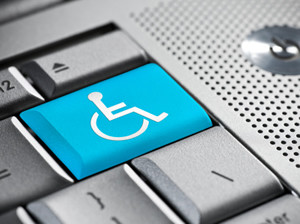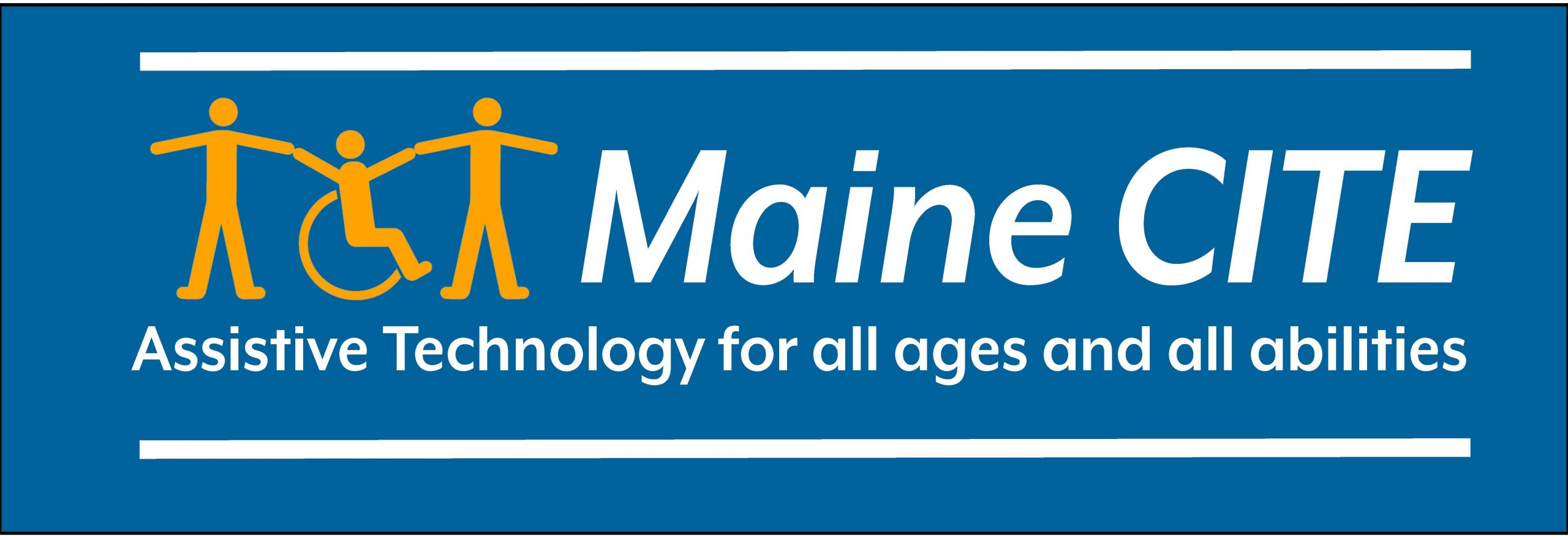Accessibility in Schools
What Maine Schools Should Know About Accessibility
 The term “accessibility” has been mentioned a great deal lately and Maine CITE is providing this article to clarify information and provide an update on the latest developments and laws that schools in Maine should know about.
The term “accessibility” has been mentioned a great deal lately and Maine CITE is providing this article to clarify information and provide an update on the latest developments and laws that schools in Maine should know about.
What is Accessibility?
Not all people are the same and not all people use technology in the same way. Some people, because of their disability, need specialized equipment and software, called assistive technologies (AT), that allow them to participate, contribute and collaborate more fully. Making websites and digital content accessible means you are making sure it works with all kinds of AT and that everyone can “access” the content.
What do schools need to be concerned about?
While modern school buildings are generally built with physical accessibility in mind (think ramps, elevators, accessible bathrooms), there are two general areas of concern when it comes to a school’s digital environment. First, websites and software applications that schools use or develop need to meet accessibility standards and guidelines. And second, all digital content that is “public facing” – created for public consumption – needs to be accessible to everyone. This means that schools’ websites, all instructional materials and all communications with the public – including digital communications with students and parents – need to be fully accessible.
What are the standards/guidelines?
While there are two overarching laws protecting people with disabilities from discrimination, the Americans with Disabilities Act (ADA) and Section 504 of the Rehabilitation Act of 1973, both laws were enacted before the widespread use of desktop computers. There are, however, two major sets of standards/guidelines that schools can use to help them make their websites and content accessible.
Section 508
Section 508 (also of the Rehabilitation Act of 1973), which deals with information and communications technology in federal procurement, is often cited as the set of guidelines that government entities (including agencies of state and local government, universities and schools) should follow. There are also the international Web Accessibility Content Guidelines (WCAG), developed by the World Wide Web Consortium (W3C), which have sections for website accessibility, as well as other forms of digital content.
On January 9, 2017, the U.S. Access Board released a final rule that updates accessibility requirements for information and communication technology (ICT) in the federal sector covered by Section 508 of the Rehabilitation Act. The rule also refreshes guidelines for telecommunications equipment subject to Section 255 of the Communications Act. The rule jointly updates and reorganizes the Section 508 standards and Section 255 guidelines in response to market trends and innovations, such as the convergence of technologies. The refresh also harmonizes these requirements with other guidelines and standards both in the U.S. and abroad, including standards issued by the European Commission and with the Web Content Accessibility Guidelines (WCAG), a globally recognized voluntary consensus standard for web content and ICT. In fact, the rule references Level A and Level AA Success Criteria and Conformance Requirements in WCAG 2.0 and applies them not only to websites, but also to electronic documents and software.
How can I find out if our website meets these standards?
There are several free tools to assess the accessibility of websites and on-line content. The most widely known is the WAVE, a free on-line tool developed by WebAIM.org. WAVE is located at wave.webaim.org and there is a free plugin that can be used with Chrome browsers to immediately test web sites.
In addition, there are numerous other plugins and “validation” sites that provide a similar service. We have posted a number of these on the Accessible Web Design section of the Maine CITE website – (see Accessibility Validators and Tools toward the bottom of the page).
For organizations with a large amount of digital content, it may be necessary to purchase the services of a professional accessibility auditing firm who will test all your content and provide some consultation on how to remediate the inaccessible materials.
Often it is useful to test web sites with real AT. You can conduct your own test using some standard AT built into your computer or mobile device. VoiceOver on macOS and iOS can easily be turned on and used to “listen” to what your web pages will sound like to a person with blindness or low vision. There are similar tools for Windows and Linux-based OSs and some free and open source tools available for download.
You can also activate the “zoom” or magnifier in your operating system to see what your content looks like to a low vision user, making sure that images and other content do not become distorted when they are enlarged.
How can I determine if our digital content is accessible?
 Evaluating your digital content can also be easy to do if you have the right software. The latest version of Microsoft Office (MSO) for both Windows and Mac have a built-in Accessibility Checker that can be used to test word processor documents, spreadsheets and presentational documents.
Evaluating your digital content can also be easy to do if you have the right software. The latest version of Microsoft Office (MSO) for both Windows and Mac have a built-in Accessibility Checker that can be used to test word processor documents, spreadsheets and presentational documents.
Google documents may be tested for accessibility by using a free Chrome extension called Grackle Accessibility Checker.
If you use a lot of Portable Document Format (PDF) documents in your school, there is a similar accessibility checker available in Adobe Acrobat Pro DC (for both the Windows and Mac versions) that will allow you to test your PDFs. But unlike the MSO feature, it is not very easy to make an inaccessible PDF into an accessible one. The better strategy is to ensure your original document is accessible before converting/saving it as a PDF. And one word of caution: PDF’s made from MSO documents on the Mac or any PDF made from Google docs cannot be made accessible. Until MS/Apple and Google fix these flaws, you will need to have a Windows machine handy to make accessible PDFs.
Care must also be taken to ensure all video content – specifically that with human speech included – is properly captioned and all audio content (e.g., podcast materials) has a text transcript. Schools that broadcast live events to the public are required to ensure they are closed captioned using a service called CART (Communication Access Realtime Translation). See more information about Captioning Video.
What will happen if we don’t make our website and digital content accessible?
This is a difficult question to answer. In the past few years, there have been reported cases of school districts who have had legal actions taken against them by the Office of Civil Rights (OCR) of the United States Department of Education. In recent cases (Seattle, WA and Santa Fe, NM), the districts signed off on rather extensive Resolution Agreements which included continued monitoring by the OCR for compliance. Between legal fees, staff time and the requirement to hire new personnel, the cost to these districts were substantial.
How do we get started?
It is always a good idea to develop a plan! Recently, Maine CITE has been working with the University of Maine System to address their accessibility needs. Over the past two years, a committee of stakeholders has been meeting to write a new policy document which describes actions and responsibilities, and a policy implementation plan which spells out the steps needed to successfully achieve the goals of the policy.
While there will be costs associated with this policy and implementation – both in actual dollars and commitment of staff time – the cost and risk of doing nothing may be significant. We recommend that a good first step would be to bring together a group of stakeholders in your school – including parents and board members – and begin the conversation. One of your next steps might be to do a simple audit and review of your websites, applications and digital content.
The Maine CITE and the Maine AEM Program web sites have lots of resources and links to other resources to help you with this effort. Another great resource is Planning and Managing Web Accessibility on the W3C’s Web Accessibility Initiative website.
Similar resources may be found at these sites:
- Improving Website Accessibility – Section508.gov
- 8-Step Implementation Model – WebAIM
- GOALS Benchmarking and Planning Tool – National Center on Disabilities and Access to Education
- Accessibility Tools and Resources: Getting Started with Accessibility – Center for Technology and Disability
- Digital Accessibility Toolkit: What Education Leaders Need to Know – Center for Technology and Disability
- Making Content Accessible for All Students – Center for Technology and Disability
Summary and Resources
We recognize that addressing accessibility issues in your schools may be a large and foreboding task. If taken in small steps, with an eye to the future, you and your colleagues will be able to make progress to ensuring all of your students and families can fully participate.
We are developing a new resource for educational institutions on the Maine CITE website where we will add this article with additional resources. You can also use the many training webinars that we have archived on our Training page.
Below are some recent articles that have more information and information:
- Writing a solid accessibility policy – NCDAE
- Organize a Web Accessibility Committee – WebAIM
- School web accessibility starts with ADA and 508 compliance – Campus Suite.
- Website Accessibility: Ten Things School Districts Should Know – Education Week – August 3, 2016.
- Why Public Schools Need to Audit Their Website for Accessibility Right Now – 3Play Media.
- Digital Accessibility Toolkit – Center on Technology and Disabilities – PDF.
- Accessibility for All Students – SETDA – OER Case Studies.
rev: 05/26/2020
